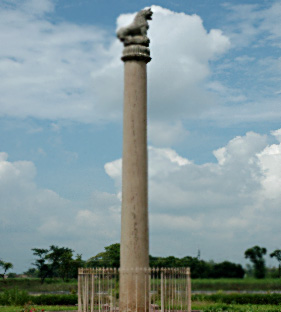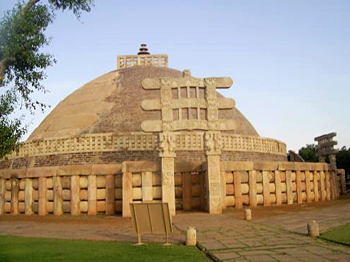 Buddhist art developed to the north through Central Asia and into Eastern Asia to form the Northern branch of Buddhist art. It had spread to Southeast Asia to form the Southern branch of Buddhist art. In India, Buddhist art prospered and influenced the development of Hindu art. Buddhist art is meant for those monuments and paintings whose main purpose is the edification of Buddhism.
Buddhist art developed to the north through Central Asia and into Eastern Asia to form the Northern branch of Buddhist art. It had spread to Southeast Asia to form the Southern branch of Buddhist art. In India, Buddhist art prospered and influenced the development of Hindu art. Buddhist art is meant for those monuments and paintings whose main purpose is the edification of Buddhism.
Pre Buddhist Art in India
During the Vedic period, Hindu art was not found probably because of the perishability of the medium or because of absence of idol-worship. The art is non-Aryan which is mainly found in the Indus valley. This art is based on elements and materials of popular religion and folklore. The Indus art was represented by large towns, seals, sculpture, pottery, jewels and figurines. The art was utilitarian represented by baths and granaries. In the Central plateau there are paintings on rocks. Such paintings are found for instance in the Son Valley in Mirzapur district, in Manikpur and its neighbourhood, in Hoshangabad District and in Panchmarhi. They depict hunting scenes, pastoral life and dancing. The primitive art was concerned with worshipping the deities like the Yakshas, Nagas and feminine deities that signify powers of fertility. This popular art was the precursor of the art of the cultured classes, attaining its first great development in the time of Ashoka and it is seen in his pillars.
Early Buddhist Art in India
 It is represented by religious monuments which are of two kinds, namely, rock-cut and structural. The latter comprises of two principal varieties, the Stupa and the temple. There is no representation of Buddha himself. He is being represented by symbols like footprints. Structural monuments are found in Sanchi Stupa, Sarnath, Bharhut, Taxila, Amravati, and Nagarjunakonda. Rock cut architecture in Barabar and Nagarjuni hills in Bihar, Bhaja, Bedsa, Elephanta caves, Ajanta caves and Ellora caves in Western India, Mahabalipuram, Undavalli and Bhairavakonda in Madras while those of the temple are found in Sanchi, Besanagar, Taxila, Deogarh, Bhitargaon, Badami, Bodh-Gaya and Nalanda. Asokan sculptures are masterpieces in style and technique. The Asokan capital at Sarnath is a great example.
It is represented by religious monuments which are of two kinds, namely, rock-cut and structural. The latter comprises of two principal varieties, the Stupa and the temple. There is no representation of Buddha himself. He is being represented by symbols like footprints. Structural monuments are found in Sanchi Stupa, Sarnath, Bharhut, Taxila, Amravati, and Nagarjunakonda. Rock cut architecture in Barabar and Nagarjuni hills in Bihar, Bhaja, Bedsa, Elephanta caves, Ajanta caves and Ellora caves in Western India, Mahabalipuram, Undavalli and Bhairavakonda in Madras while those of the temple are found in Sanchi, Besanagar, Taxila, Deogarh, Bhitargaon, Badami, Bodh-Gaya and Nalanda. Asokan sculptures are masterpieces in style and technique. The Asokan capital at Sarnath is a great example.
Buddhist styles are natural in design; with a distinct element of sensuousness, its wood-carving technique, and the general absence of foreign influences make it distinct. Animals are represented beautifully.
Itushan or Graeco-Buddhist Art in India
In this phase there are controversies as to how the Buddha statue developed. The statue was a foreign importation or an indigenous evolution is doubtful. Lord Buddha was first represented by his relics, personal possessions and trees, then by his life and later through his material form. Mathura and Gandhara schools of art claim this honour and it may probably be the case that both developed this form simultaneously. Buddha with a moustache as in the Gandhara style is Greek and unthinkable in the Indian system where Buddha the Yogi reminds one of the Vedic conceptions. The Mathura style resembles the forms of divinities as found in Bharhut. Thus the Buddha image is Indian in both conception and origin and is fashioned strictly according to the iconographic traditions embodied in the older indigenous works. The Kushan art is to be found in Afghanistan, Mathura, Kashmir, Besanagar and Amravati. The Gandhara art is a fusion in which provincial Roman forms are adapted for the purpose of Indian imagery. Mathura art is natural, direct and vibrant.



















